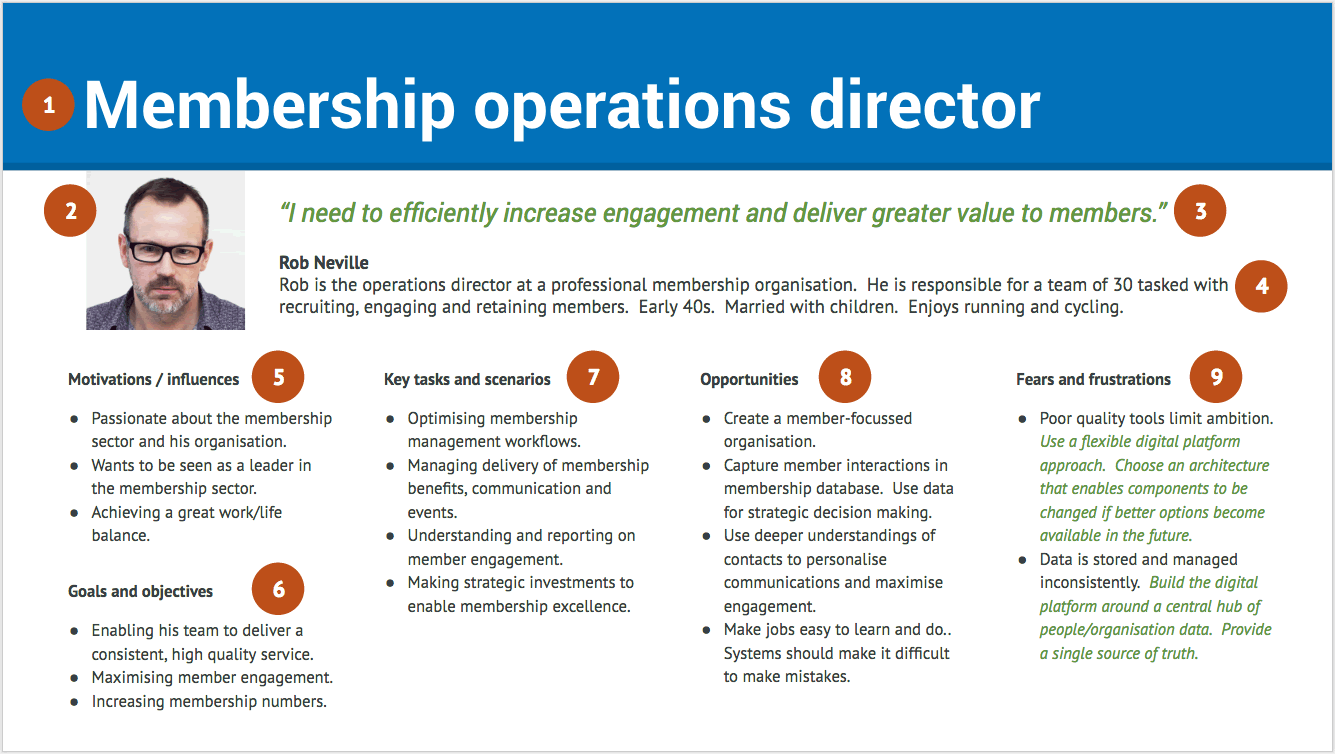
User personas: what they are and how to build them
Successful organisations are characterised by their ability to solve real world problems.
To achieve this, an organisation’s systems and workflows must be designed to meet the real needs of customers, members and/or service users.
This article explains how to discover these requirements and capture them in a meaningful and useful format: user personas.
How to find out the needs of our users
Every organisation has some sense of who their users are and what they’re looking to do.
This existing understanding typically resides in the heads of key individuals, and is rarely captured in a useful and accessible format. There are often differences in opinion and gaps in this knowledge.

We need to explore this existing knowledge, fill in the gaps and record it for future use.
The first step is to identify and understand the information that is already known. I do this through a stakeholder consultation session. This is a meeting with key individuals where we discuss the purpose of the organisation and who the different audiences are.
Most organisations identify between 5-8 different audiences. These often involve one or two internal user groups.
For each audience, we talk through their motivations, the jobs they need to complete, areas of frustration and the opportunities we have to deliver more value.
These discussions uncover many of the real user requirements. For some projects this can provide enough information to move forward with planning and scoping.
At this stage, it’s common to identify unanswered questions and opinions based on untested assumptions. Further research is required to answer these questions and validate our understanding.
This research starts with a user survey. We include questions to confirm our existing knowledge and address any uncertainties uncovered in the stakeholder consultation.
If we need more detail, for example to explore new ideas or specific concerns, we can run additional surveys, group discussions and/or one-to-one interviews.
Presentation
Surfacing information and ideas is the easy part. Everyone likes to have their voice heard.
The challenge is bringing all the information together into a useful and accessible resource. This is where the personas format works well.
There is no regulated ‘persona template’. We just need a format that is easy to understand.
I’ve used a variety of approaches over the years and have settled on the following format:

Each persona comprises:
- Title – to succinctly describe the audience group.
- Photo – to make each persona more memorable.
- Summary sentence – a headline summarising the needs of this persona.
- Name and background – to help visualise someone in this audience group.
- Motivations / influences – what inspires interaction with the organisation.
- Goals and objectives – broad outcomes this audience group wants.
- Key tasks and scenarios – steps likely to be taken to achieve the goals and objectives.
- Opportunities – things we can do to deliver added value.
- Fears and frustrations – anything that gets in the way. We also note how we address these (or plan to).
The name and background are usually fictitious, with the photo obtained from stock. They’re included to provide a personality and help the reader identify with the audience being described.
A full personas document includes an introduction with the notes above and ranks the audiences by importance.
I produce personas in Google Slides. Google Slides works well because:
- It’s flexible and suits the format well.
- Everyone works on a single document, and all changes are tracked.
- Creating a PDF version is easy.
Maximising value
The process of building personas as a group is quite fun and results in many useful insights for those present.
Maximum benefit is achieved when the information acquired results in a unified understanding across the organisation.
This shared knowledge comes from capturing the audience needs in a simple, accessible document, and then:
- Using the personas when planning new activity: anything from a blog post through to a new digital platform.
- Including the personas when training staff and briefing external partners.
- Updating the personas whenever audiences change or new information comes to light. (I also recommend a scheduled annual review).

Summary
Projects and organisations are successful when they meet the real needs of the people they’re serving.
Creating personas is a great way to explore these needs and capture them in a simple and accessible format.
The personas can then be easily referenced by anyone planning new projects or activity. This promotes a shared understanding between everyone involved.
Documented personas are a strategic asset. Using them when planning new initiatives and updating them with new learnings helps to achieve that pinnacle of success – the customer-focussed organisation.
Comments